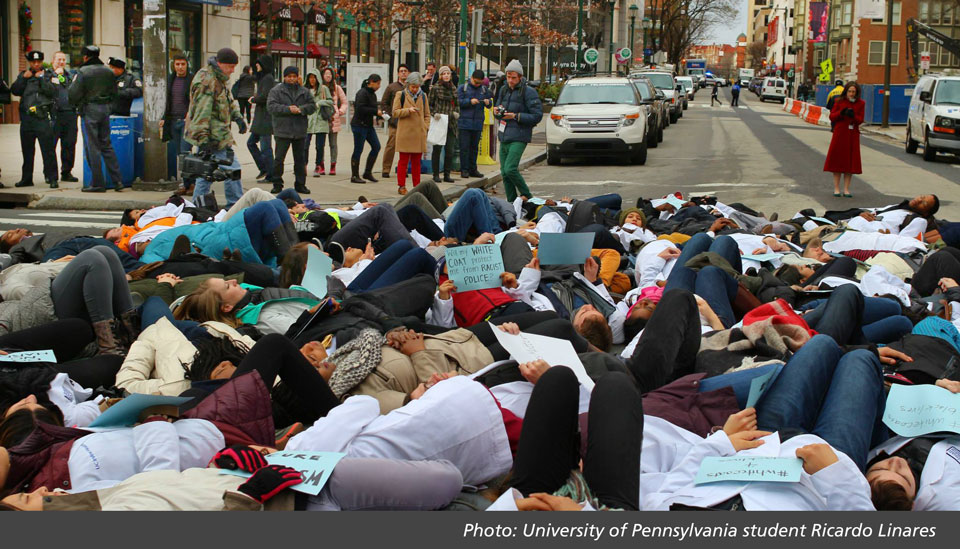There are nearly as many guns as there are people in the United States–up to 310 million held by private citizens alone. Even without the Second Amendment, guns aren’t going away. So is it possible, in a country with just as many guns as people, to decrease this kind of violence?
Without much fanfare outside of the medical field, seven national groups representing physicians and other health professionals have recently come together and issued a statement to say, ‘Yes, less gun violence is possible.’
They’ve also agreed on specific policies to get the nation to this new normal. Calling guns "a public health problem," they cite not just recent mass shootings, but the sobering fact that there are 88 gun-related deaths per day in this country. They point out that guns are the second leading cause of death among Americans under the age of 25. This says nothing of injuries, which are more than double the number of deaths. And gun violence doesn’t just reach its physical victims. More than one in five U.S. teenagers ages 14 to 17, according to a 2009 Department of Justice study, report having witnessed a shooting.
"This is a very public statement from the public health community that one, we’re paying attention to this issue, [and two] we don’t think this is something that has to continue to plague our community," says Shannon Frattaroli, professor and an associate director of the Center for Injury Research and Policy at Johns Hopkins University. "When you go for your annual check-up or go into the emergency room for a broken leg, perhaps your doctor doesn’t just care about your leg. She cares about what’s happening in your community and the role guns play in your life, too."
So, can doctors influence the public debate to rein in gun violence, just as they did with cigarette-smoking, using a seatbelt or eating right to fight heart disease? Colorlines talked to doctors and other public health experts, all of whom are deeply involved in gun-violence prevention, to find out.
Doctors see what the rest of us don’t; it leaves an impact.
Most gunshot victims survive their wounds. What’s largely unseen is that not many live well, after. "This goes further than the emergency room," says Sarah Kimball, M.D., an internist who works out of a Boston University-affiliated "safety net" clinic that serves Medicaid recipients. Among her patients, she says, are too many 18- to 35-year-olds who otherwise should be healthy but are suffering lifelong challenges as a result of being shot.
"I see young people with chronic bladder problems, chronic pain, or severe vascular damage*, which means they end up in the emergency room quite frequently," Kimball says. "These are chronic issues that change and destroy someone’s life–and keep them looped into the medical system."
Because of her young patients, Kimball got involved in a gun violence task force through the National Physicians Alliance. She recognizes that, "it’s easy for doctors to be complacent about larger political and national issues as most of our advocacies happen one-on-one," in private, in the doctor’s office. But what concerns her, she says, is the politicization of a public health epidemic. For example, a federal court last year upheld Florida’s 3-year-old law banning healthcare providers from talking to patients about their guns.
A new generation of African-American doctors know gun violence, intimately.
Loren Robinson, M.D., knows well the impact of gun violence, and not because her pediatric practice where she sees patients up to age 22, is located in West Philadelphia. A younger cousin died a few years ago after police shot him while responding to a home invasion at his house. It was a case of mistaken identity.
"People assume we’ve been in these Ivory Towers and haven’t had other experiences, but there’re a lot of younger physicians with direct life experience with gun violence and it colors how we see the issue," says Robinson who’s also involved in #WhiteCoats4Black Lives. The med-student led campaign initiated an 80-college die-in last December. On Martin Luther King Jr. Day, participants established themselves as a national student organization.
Whether it’s coming from police or the street, Robinson is concerned with how all gun violence fractures communities of color. (Nationally, people of color comprise about 13 percent of doctors. African-Americans, 4 percent.) "Some people say we’re trying to take away all gun ownership, but I don’t even think that’s something that’s feasible. We won’t see a day when personal gun ownership is disallowed." Robinson says. "But I think we can be smarter about it. Gun violence is out of control."
Doctors have a unique voice and role to play in decreasing gun violence.
Doctors deal daily with the consequences of gun violence and they’re positioned on the front lines of prevention, too, Frattaroli says. But more than that, Robinson says, doctors still maintain a position of authority and trust in American society.
"I think there’s an understanding that we’re people who’re committed to truth and the facts," Robinson says. "Also, as healers weighing in on this issue, [doctors’ voices] carry a particular weight that not other fields or professions can have. There has been a lot of distrust in government, police and even in the church or clergy. And I think medicine is one of the last fields that hasn’t been disassembled by mistrust."
* Post updated to replace "clotting disorders" in order to be more medically accurate
